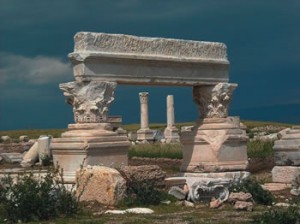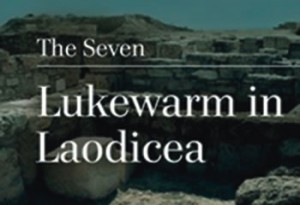The Book of Revelation (2)
Chapters 1 to 3
The inaugural vision of the Risen Christ fills chapter 1. John uses symbols that would be familiar to his first readers/hearers. Jesus is the “firstborn of the dead, and ruler of the kings of the earth,” an echo of Psalm 89:27 where God appoints David by the title “ruler of the kings of the earth.” This title could be viewed by Roman authorities as seditious. Caesar was the emperor and the ruler of the kings of the earth. But John accords this title where it truly belongs – to Jesus. Jesus being firstborn from the dead has in view his status as the first human to be resurrected. The description of Jesus is highly symbolic (he doesn’t really have feet like burnished bronze), but John wants to convey the power and majesty of the Risen Lord.
Christ wears a long robe reminiscent of a priestly robe, for by his redemptive sacrifice Jesus has won us freedom from sin and death (the death of apostasy, not physical death). Christ also wears gold, for he is royal, and white, for he is a conqueror. Many of the images John uses here are from the Old Testament. Many will be used again in the messages to the churches.
Seven messages to seven churches
Chapters 2 and 3 contain seven messages to seven churches on the mainland. John, writing from exile on the island of Patmos (20 miles offshore), sends these messages to particular congregations. Why seven? Why these seven? Seven in the bible is a highly symbolic number suggesting fullness and completeness. Therefore, the seven churches represent all churches then and now. As to why the particular seven, it may be that these were the churches with whom John was most familiar. They also formed a loop on a Roman postal route. There were other churches in the area – Colossae for one. Space does not permit us to examine each church in great detail, but we will group them into three categories according to a predominant problem in each.
Assimilation
The problem of assimilation challenged the churches at Ephesus, Pergamum and Thyatira. Could Christians worship Christ but still participate in civic activities connected with pagan Roman religion? Could they join business guilds and dine at their banquets even though the dinner included a sacrifice to a pagan deity? There were groups within the Christian community which advocated accommodations to pagan religions. We do not know their precise teachings, but the Nicolaitans, otherwise unknown, were one such group. John calls some others followers of Balaam. This Old Testament character appears in Numbers 31:16 as one who misled the Israelites into pagan worship. John is faced with a competing ‘prophet’ whom he designates ‘Jezebel.’ This was the name of a pagan queen of Israel, known for her ruthlessness and for leading Israel to the worship of the pagan god Baal. Her story is found in 1 Kings 16-22.
Persecution
The problem of persecution affected the churches in Smyrna and Philadelphia. Contrary to what was once assumed, there was no empire wide persecution in the last years of the first century. While it is true that the emperor Domitian did claim divinity, he tended to let the local officials in each area promote this claim. The local officials in the province of Asia (where the seven churches were located) were very eager in this task. True Christians undoubtedly stood out against the background of pagan ceremony and ritual. Refusal to participate in the worship of the emperor, of Rome itself as a goddess, and the other local gods and goddesses would have brought penalties (at least being ostracized from the life of the community, and possibly economic penalties direct or indirect). Revelation only tells us of one actual martyr, Antipas, but we should not minimize the pressure being brought to bear upon faithful Christians.
Complacency
The problem of complacency affected the churches of Sardis and Laodicea. The members of these congregations did not have to fear persecution; they were all too comfortable with a shallow faith in the midst of a pervasive pagan atmosphere. Jesus addresses these congregations (and remember it is the risen Lord who addresses the churches through his prophet John) with the challenge to shed their complacency and return to a vibrant Christian faith and practice. In calling for watchfulness on the part of the church in Sardis, Jesus may well be recalling how twice in its history, Sardis had been captured because of the lack of watchfulness on the part of its guards. And Laodicea is described as neither hot nor cold. This probably refers to the fact that the aqueducts that brought water to the city brought a mixture of hot and cold water, a lukewarm and unpalatable drink. Jesus threatens to spit the Laodiceans out of his mouth like this tepid water.
Challenges
All of the seven churches are challenged to strengthen their good ways or correct their weaknesses. The messages need not be the final words to the churches. Always, Jesus hopes for seven churches that will all be like Smyrna and Philadelphia. Also, while we’re talking of the churches, we need to emphasize that these were seven real communities in the first century. They can teach us about fidelity or the lack of it, but they are not merely symbols. Nor do they represent, as some maintain, ages in the history of the Church.
It is also important to remember that the fact that there was tension between Christians and Jews in the seven cities does not validate any modern hatred between the two religions. John himself was most likely a Palestinian Jew, so we are not dealing with anti-semitism. By disowning Christians as no longer a part of Judaism, Jews were depriving the Christians of some Roman legal protections. This is the cause of the sharp language by John in these letters.
Reading ahead:
Chapter 4 through chapter 8:2

 Entries(RSS)
Entries(RSS)